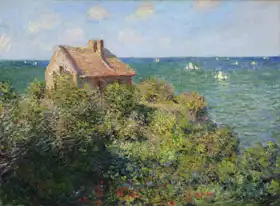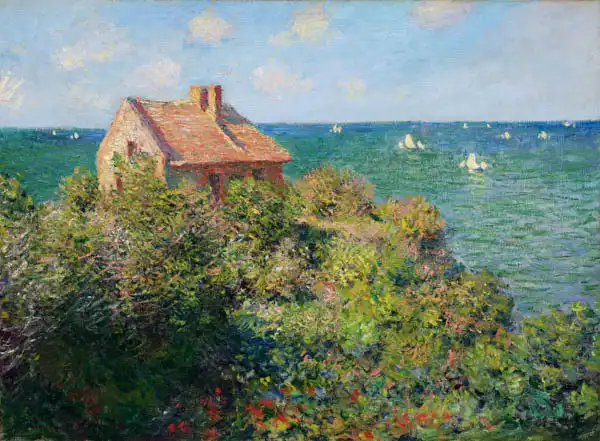Fisherman s cottage at varengeville
Date:
1882Fisherman's Cottage near Varengeville is a painting by the famous French
impressionist painter
Claude Monet . He created this painting in 1882 during his stay in the small fishing village of Varengeville-sur-Mer on the northern coast of France. The painting depicts an old, rustic fisherman's cottage that stands on a cliff above the
sea . The cabin has a rough wooden structure and a thatched roof. It is surrounded by green plants and bushes.
Monet was known for his ability to capture light effects and atmosphere. His typical way of capturing light and shadow can be seen in this painting. The sun's rays break through the clouds above the cabin and create a changing play of light on the landscape.
Monet used a bright and vivid color palette, which is typical of Impressionism. Here you can see the blue sky, different shades of green for the vegetation, and different shades of brown for the cottage.
Monet's work was a key example of Impressionism, an art movement focused on capturing the moment and atmosphere rather than rendering it in detail. The image is out of focus and creates the impression of rapid movement and change.
Monet painted picture Fisherman s cottage at varengeville in 1882. Prevailing color of this fine art print is green and its shape is landscape. This image is printed on demand - you can choose material, size and finishing.
Claude Oscar Monet (1840-1926). A native Parisian, who thoroughly developed the idea of
Impressionism. Monet almost scientifically studied the effect of light on different objects. He devoted himself to so called transitory states, which quickly led him to work with colour and light, his paintings acting on the viewer from the first impression. His use of open-air painting and objects which were special only because of light opened the way for the beginnings of modern painting. Monet’s
Impression, Sunrise (1874) not only gave the name to the whole art movement, but secured Monet a place among the best painters of all times. At one time, he resided in London and created his famous study
Houses of Parliament (Monet wondered, How could the English painters paint Parliament when it cannot be seen for the fog?). In the
Giverny, which became his favourite retreat after the death of his wife, he painted motifs from his garden and the popular series
Water Lilies - the world of the water was as poetic and mysterious as a primordial paradise.


